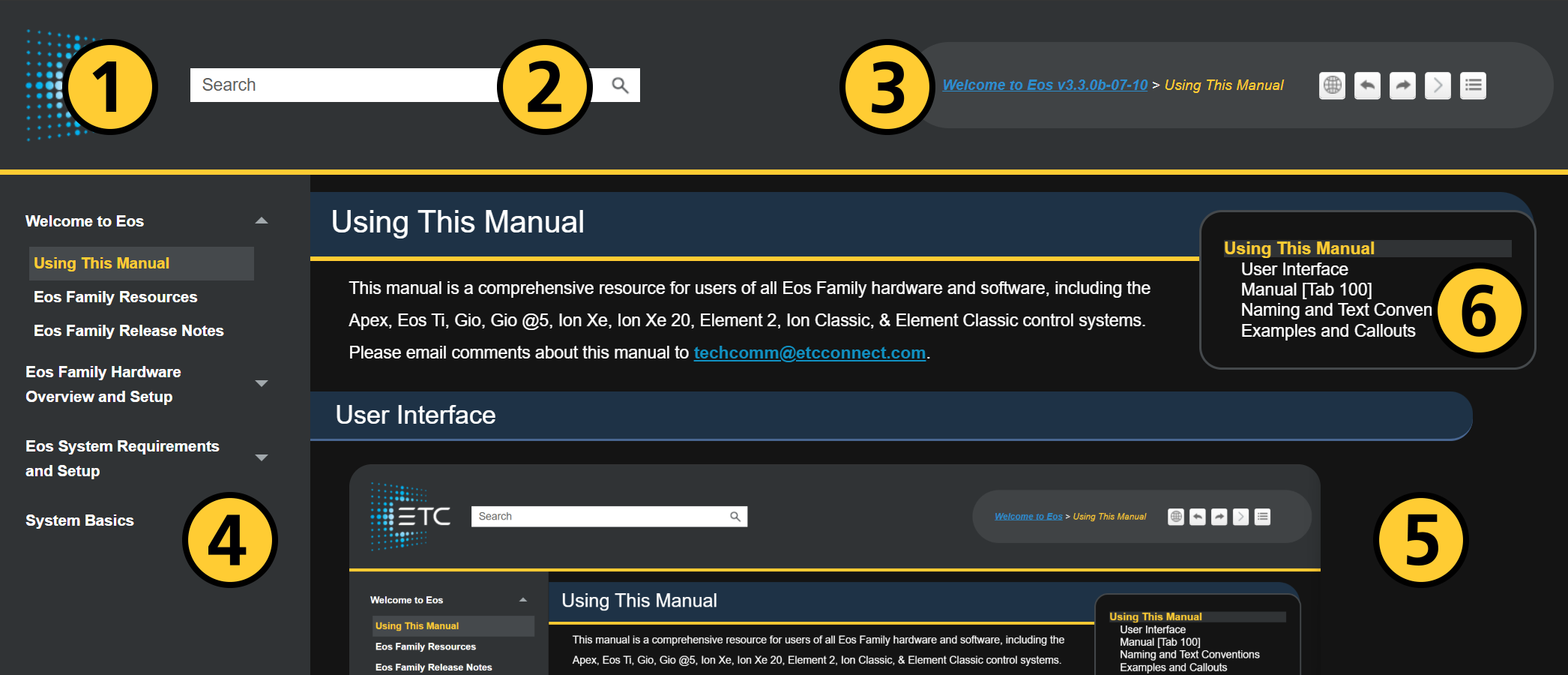Using This Manual
This manual is a comprehensive resource for users of all Eos Family hardware and software, including the Apex, Eos Ti, Gio, Gio @5, Ion Xe, Ion Xe 20, Element 2, Ion Classic, & Element Classic control systems.
Please email comments about this manual to techcomm@etcconnect.com.
User Interface

Home
Use the
In mobile view, the Eos logo is replaced by a home button in the toolbar.
Search
The search header is
Toolbar and Breadcrumbs
The toolbar is also
The following buttons are available:
| Home |

|
Returns you to the home screen. Replaces the Eos logo in mobile view. |
| Change Language |
|
Select English, German, French, or Spanish from the dropdown list. |
| Expand and Collapse All |
|
Open or close any collapsible content in the open topic. Closed by default. |
| Previous and Next Topic |
|
Opens the previous or next chronological manual topic. To navigate to a page you previously had open, use your browser forward and back buttons. |
| Topic Menu |
|
Hide or show the topic menu. Only available in the online Eos Family manual in web view. |
The breadcrumbs indicate the location of the currently-open topic, with links back to higher-level sections and chapters. Breadcrumbs are hidden in mobile view.
Table of Contents
The table of contents sidebar menu is always available on the left of the screen, highlighting the open topic within the current section of the manual. On Eos consoles and smaller tablet and mobile screens, the contents can be expanded and collapsed with the menu button icon in the top left.
Select a section to view its landing page and expand the list of topics in that section. Top-level landing pages only provide links to topics, while those further down may also provide additional information. Use the contents in the sidebar menu, links on the page, or the Previous and Next Topic buttons in the toolbar to view specific topics.
Topic
The currently open or selected topic appears in the main portion of the screen.
Use the Return to Top option at the bottom of any page to scroll back to the top of the open topic.
Topic Menu
The topic menu can be used to jump to specific headings in the open topic. The current heading level will be highlighted in the menu as the page is scrolled.
Manual [Tab 100]
The manual can be opened within the Eos application via the Workspace Layout Menu or by using [Tab] & [1][0][0].
Naming and Text Conventions
In order to be specific about where features and commands are found, the following naming and text conventions will be used:
- Browser menus and commands are indicated in bold text. For example, in the File menu, select Open.
- Alphanumeric keyboard buttons are indicated in all CAPS. For example, ALT or CTRL.
- Face panel buttons (hardkeys) are indicated in bold [brackets]. For example, [Live] or [Enter].
- Softkeys, direct selects, and other virtual buttons are indicated in bold {braces}. For example, {Address}.
- Optional keys which don't have to be pressed are indicated in <angle brackets>. For example, <Cue> or <0>.
- Non-specific hardkey and softkey syntax is indicated with descriptive text within bold brackets. For example, [Channels] to indicate a selection of a range of channels.
- Keys which are intended to be pressed or held simultaneously are indicated with an ampersand (&). For example, [Load] & [Timing Disable].
- Links to other topics are indicated in bold underlined blue; for example, Important Concepts. Use the link to jump to that section of the manual.
Examples and Callouts
Syntax tables provide examples indicating how to use The Command Line to enter and perform specific operations.
| Action | Syntax | Notes |
|---|---|---|
| The operation to be performed. | How to enter the operation on the command line. | Additional information. |
Notes indicate useful information supplemental to the main text.
Note: If you're reading this, we appreciate you.
Caution and warning callouts are used to call your attention to important information:
CAUTION: Cautions indicate situations where there may be undefined or unwanted consequences of an action, potential for data loss, or an equipment problem.
WARNING: Warnings indicate situations where damage may occur, people may be harmed, or there are serious or dangerous consequences of an action.
Information in expandable dropdowns is indicated at the beginning of the topic or section.
Expand individual sections below to view more information, or use the Expand All button in the topic toolbar.





